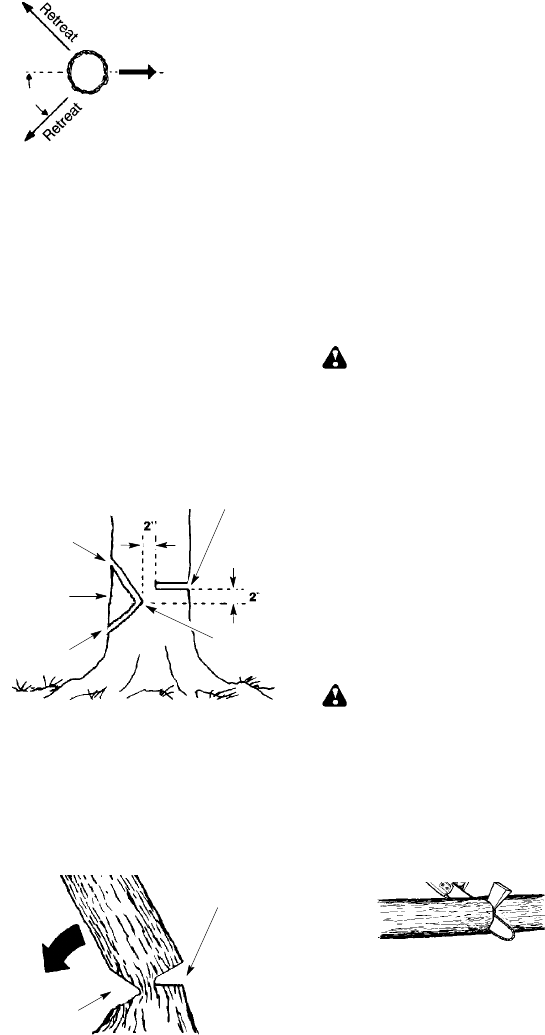
12
Direction of Fall
45_
Plan a clear retreat path
FELLING LARGE TREES
(6 inches (15 cm) in diameter or larger)
The notch method is used to fell large trees.
A notch is cut onthe side ofthe t reein thede-
sired direction of f all. After a felling cut i s
made on the opposite side of tree, the tree
will tend to fall into the notch.
NOTE: If the tree has large buttress roots,
remove thembefore making the notch. If us-
ing saw to remove buttress roots, keep saw
chain from contacting groundto preventdull-
ing of the chain.
NOTCH CU T AND FELLING THE
TREE
S Make notch cut by cutting the top of the
notch first. Cut through
1/3 of the diameter
ofthe tree. Nextcomplete thenotch bycut-
ting the bottom of the notch. See illustra-
tion. Once the notch is cut remove the
notch of wood from the tree.
Notch
First cut
Second cut
Final (felling) cut here, 2 inches
(5 cm) above center of notch.
Hinge
S After removing the wood from the notch,
make the felling cut on the opposite side of
the notch. This is done by making a cut about
two inches (5 cm) higher than the center of
the notch. This will leave enough uncut wood
between the felling cut and the notch to form
a hinge. This hinge will help prevent the tree
from falling in the wrong direction.
Opening of
felling cut
Closing
of notch
Hinge holds tree on stump and helps
control fall
NOTE: Before felling cut is complete, use
wedges to open the cut if necessary to
controlthedirection offall. To avoidkickback
and chain damage, use wood or plastic
wedges, but never steel or iron wedges.
S Be alert to signs that the tree is ready to fall:
cracking sounds, widening of the felling cut,
or movement in the upper branches.
S As tree starts to fall, stop saw, put it down,
and get away quickly on your planned re-
treat path.
S DO NOT cut down a partially fallen tree
with your saw . Be extremely cautious with
partially fallen trees that may be poorly
supported. When a tree doesn’t fall com-
pletely,set thesaw asideand pull downthe
tree with a cable winch, block and tackle,
or tractor.
CUTTING A FALLEN TREE
(BUCKING)
Bucking is the term used for cutting a fallen
tree to the desired log size.
WARNING: Do not stand on the log
being cut. Any portion can roll causing loss
of footing and control. Do not stand downhill
of the log being cut.
IMPORTANT POINTS
S Cut only one log at a time.
S Cut shattered wood very carefully; sharp
pieces of wood could be flung toward opera-
tor .
S Use a sawhorse to cut small logs. Never
allow another person to hold the log while
cutting and never holdthe log with your leg
or foot.
S Do not cut in an area where logs, limbs,
and roots are tangled such as in a blown
down area. Drag the logs into a clear area
before cutting by pulling out exposed and
cleared logs first.
TYPES OF CUTTING USED FOR
BUCKING
WARNING: If saw becomes
pinched or hung in a log, don’t try to force it
out. Youcan lose control o fthe saw r esulting
in injury and/or damage to the saw . Stop the
saw, drive awedge ofplastic or wood intothe
cut until the saw can be removed easily . Re-
startthesaw andcarefully reenterthecut. To
avoid kickback and chain damage, do not
use a m etalwedge. Do not attempt to restart
your saw when it is pinched or hung in a log.
Use a wedge to remove pinched saw
Turn saw OFF and use a plastic o r
wooden wedge to force cut open.
Overcutting begins on the top side of the log
with the bottom of the saw against the log.
When overcutting use light downward pres-
sure .


















